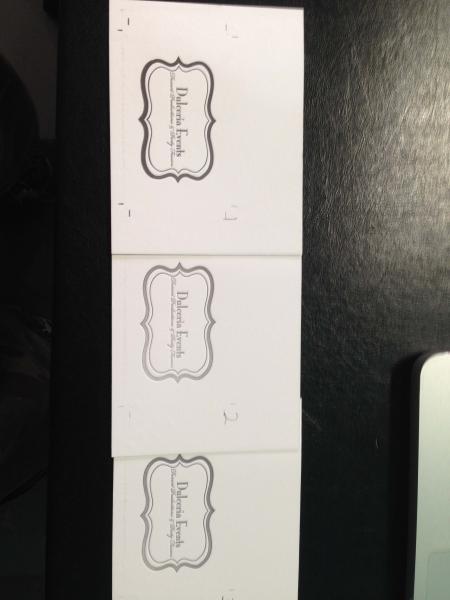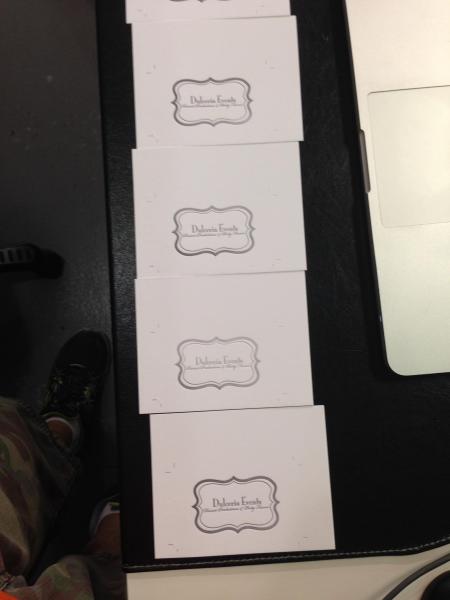Inking problems on windmill
Hi everyone we have a heidleberg 10x15 windmill blackball and recently it has been acting up. Please see attached pictures. There seems to be a problem inking consistently for short runs (no inkwell) where the first impression is fine and every impression after it is not inking properly. We have tried the following without a positive result:
1. Adjusted rollers according to manual
2. Aggressively lowered rollers to ensure inking.
3. Checked for oil on main ink roller, before and during printing.
4. Rotated rollers (like rotating tires) Twice
5. Swapped for a different set of rollers
6. Added packing behind chase
7. removed packing behind chase.
None of these have done anything to correct the problem. As you can see these are not flood areas and the run is relatively short so really there is no need for the inking well from my perspective. Any help to resolve this (I am sure some of you have already solved this, probably more than once) is greatly appreciated.

photo 1.jpg

photo 2.jpg
Just silly shots in the dark, but in view of your after *the initial impression(s) * comment, what is happening between A and B? i.e. how are you locking the forme up, on what? i.e.proper stone, flat surface, are you planing your image down, are you doing a “Lift” test!! is your image, to view/print ever so slightly dropping a few thou within the chase, after the initial or first impression(s), has the chase got an imperceptible bow on the underside and moves/settles even when clipped in, When clipped in, is your clip up to scratch.
Have you or can you rotate the image 180 degrees to prove or disprove the accuracy of your mounting base. Good Luck.!! .
I would look at the shear collar, behind the door on the back of the press, and make sure that it isn’t two pieces.
have you calibrated your tympan packing?i would use some harder packing maybe…
Have you tried adding more ink? I find the first impression is always too dark because it’s been inking the form multiple times. My 2nd print is always what I use to judge for color. It’s hard to tell in the photos, but is it consistent after the first print?
Hey Mick, the process is lock up the boxcar base with a pp plate, and run the press. There is no change from my side (i am not skip feeding, although that may be a solution) and i make no additional adjustments.
I don’t think its the shear collar since the depth of the bite on the paper is consistent and the inconsistency is in the ink.
Jonsel: the press is well inked (meaning this happens right from the get go). so lack of ink is not the issue.
Phase4: the tympan is a new red board that seems to be in good condition. it is my usual set up.
Any additional suggestions?
Try a different plate and different ink. Overload the ink and see what happens. Eliminate every possible variable. Then ink up with the fountain and see if there’s a change.
Does this happen every time you don’t use the fountain?
Yghersi, thank you for your acknowledgement, Your original resume looked very comprehensive, I was stabbing in the dark looking for a missing factor, Sorry!
Just to recap, is it possible to examine your chase on a completly flat surface, checking for *bow*, do you have access to another chase, is it remotely possible, to put your chase with locked up forme on to a Buddies, M/C. just for a proving test.. Are the 2 lugs at the base of the Bed for the chase to sit on, locked up tight.??
Noted and understood your Skip Feeding, some time ago with a Buddies Vertical Miehle, he had fitted a little attachment to do exactly that, Skip Feed/Double Roll but flipped in or out, as required, although the ink train, on the V/M, was/is quite powerful, some stock at certain speeds was tricky.
It is believed the attachment idea, came from M.G.D. (Meihle Goss Dexter, Stateside)
Apologies for more potential rubbish.! But Good Luck. Mick
Generally the print after no less than 3 impressions is an accurate picture of what you will get. If you are not running the fountain, it’s really hard to accurately meter the ink for the job (color values will vary a lot).
If you are running over 100 pieces, using the fountain will help tremendously. You will use more ink, but have much more control over what is going on. If the doctor is contacting the fountain ball, it’s fairly simple to set the keys and preload the ink onto the doctor roller before running up the ink on the main drum.
The fountain has never been used on this machine as the runs are relatively small and we have good control over manually re-inking when color changes. Given all that the problem we are having is fresh after inking, its not in the middle of the run or even after 10-15-25 impressions.
Jonsel: We have flipped the plate, tested different plates, even switched the base we use to print.
Mick, we will switch chases and redo the whole lock up to test and see if its flexing. I will post an update over the weekend (the C&P will carry the load for now) of the next step results. Will likely start from scratch beginning with rollers, and ending with a whole mechanical check.
Thanks for the feedback.
It seems like a roller problem. What condition are your rollers in? Old rollers can cause havoc.
What are you using to clean the press? Some solvents need longer times to evaporate. Perhaps your contaminating your ink? For example, if I clean up with California Wash, I typically give the press 5-10 minutes before re-inking.
Dennis: The rollers are in good shape, the trucks will be replaced.
Jonsel: We use california wash on the rollers, but for a quick plate cleaning we use alcohol which is very quick to dry.
But in this case it was a clean set up from a clean machine. We have checked for oil contamination as well, as it seems that windmills are known for it, and that was not the cause. I will work on it and post what we find.
Thanks for helping out its driving us crazy.
I would still ink up using the fountain to see if anything changes.
Also, what happens if you try skip-feeding?
Jonsel, Skip feeding resolves the issue, but I would like to resolve the cause. Skip feeding is a great band-aid but its almost as much work as printing on the C&P hand fed. I’ll update what I find after the weekend.
Yghersi, good luck with the alternative chase test! it was/is only a throw away disproving test, but one more absolutely silly one from a long long time ago, a firm I spent 14 very happy years at, until the death!! Ran (in order of size) L/press, Johannesburg,s, H/bergs, V.M. 10 x15 Platen and one time, 13 x 18 H/berg Platen, a job came through which involved 2 full out A4 plates/cuts 120 screen(ish) background tint, for the cover of a book, with the title etc overprinted.
It was run initially on the 13 x 18 with the plates mounted on Monotype 3 em x 3 em high quads, + D.S.A. + plate, first run perfect, Reprint 3/4 weeks later, big problems . eventually found (by accident) that the Eight page sections for the book which included, one eight page full 4 colour, had been locked up, again with 8 pages, on Monotype base, had to be locked up so tight , for the J/burg, that one piece of aluminium furniture, spanning the Heads of 2 pages, (the same piece used for the 2 page reprint) being *H* section had bowed, just a fraction and caused the forme to rise minutely, they tried to blame the Monotype base.!!
To illustrate the weight and lock up pressure involved on the Jo/burgs, with 8 pages and more of solid type matter up, they the formes, were so heavy, to transfer from The Stone to the Bed, they,The Formes were transported via an Hydraulic truck, i.e.table pumped up to the horizontal plane, transported vertically, lowered to the horizontal to meet the Height of the Bed.
The hydraulic ram is still in use as the motive power for my bearing press, roughly calculated at 10 tons pressure (ish).?
Seminar ends with Apologies, and Good Luck, again. Mick
Make sure the bearings are not sloppy on the journals.
OEM cores are 9.5mm which require 9.5mm ID bearings.
There are some companies that supply knock off cores
that take 10mm ID bearings. Using larger ID bearings on
smaller OD journals could be causing your problem.
I’d check the rising rails (to keep forme rollers from inking) are retracting properly. The rails and trucks are also suspect, as are the springs and shafts of the roller arms. It is easy to overlook the internal oil points on the arms and binding shafts can interfere with consistent inking.
I’d also look for anything interfering with the distribution rollers and their brackets ( the roller prop for example). The springs on the brackets can fail too.